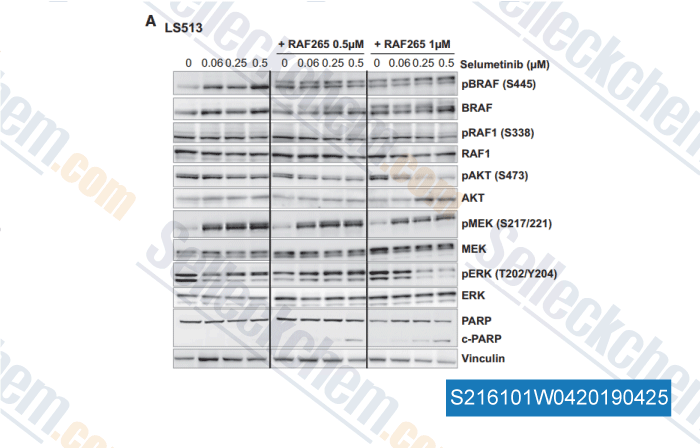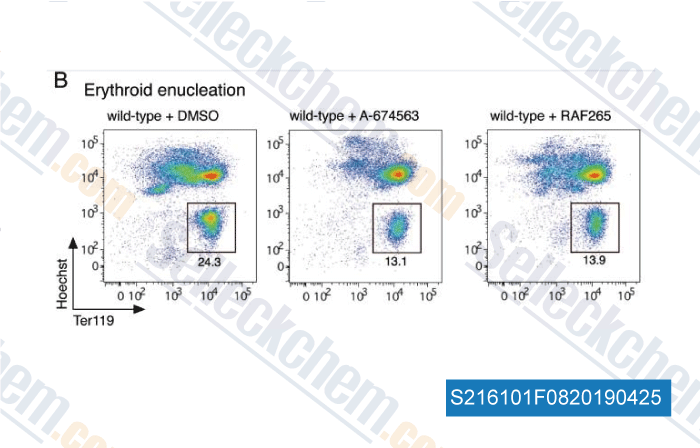|
Toll Free: (877) 796-6397 -- USA and Canada only -- |
Fax: +1-832-582-8590 Orders: +1-832-582-8158 |
Tech Support: +1-832-582-8158 Ext:3 Please provide your Order Number in the email. |
Technical Data
| Formula | C24H16F6N6O |
|||
| Molecular Weight | 518.41 | CAS No. | 927880-90-8 | |
| Solubility (25°C)* | In vitro | DMSO | 100 mg/mL (192.89 mM) | |
| Ethanol | 100 mg/mL (192.89 mM) | |||
| Water | Insoluble | |||
|
* <1 mg/ml means slightly soluble or insoluble. * Please note that Selleck tests the solubility of all compounds in-house, and the actual solubility may differ slightly from published values. This is normal and is due to slight batch-to-batch variations. * Room temperature shipping (Stability testing shows this product can be shipped without any cooling measures.) |
||||
Preparing Stock Solutions
Biological Activity
| Description | RAF265 (CHIR-265) is a potent selective inhibitor of C-Raf/B-Raf/B-Raf V600E with IC50 of 3-60 nM, and exhibits potent inhibition on VEGFR2 phosphorylation with EC50 of 30 nM in cell-free assays. RAF265 (CHIR-265) induces cell cycle arrest and apoptosis. Phase 2. | ||||
|---|---|---|---|---|---|
| Targets |
|
||||
| In vitro | RAF265 inhibits C-Raf, wild type B-Raf and mutant (V600E) B-Raf. RAF265 effectively block phosphorylation of Raf's downstream substrates MEK and ERK in cells and also kill melanoma and colorectal cancer cell lines harboring B-Raf mutations independent of PTEN mutation status. Raf kinase inhibition by RAF265 in mutant B-Raf melanoma cell lines causes cell cycle arrest and induces apoptosis, mimicking the effect of Raf RNAi in these cells. RAF265 also potently inhibits the phosphorylation of VEGFR2 and proliferation of VEGF-stimulated hMVEC. [1] In HT29 and MDAMB231 cells, RAF265 shows inhibitory activity with IC20 of 1 to 3 μM and IC50 of 5 to 10 μM, respectively. While RAF265 leads to a significant decrease in clonogenic survival in all tested cell lines, which means that RAF265 induces a dominant effect on clonogenic survival. Addition of RAF265 to RAD001 in HCT116 cells could lead to moderately decreased AKT, S6 protein, and 4EBP1 phosphorylation. [2] Raf265 markedly reduces the protein level of Bcl-2 and great inhibitory in CM- and NCI-H727 cells, while having no effect on the TRAIL susceptibility of BON1 and GOT1 cells. [3] Protein kinase D3 (PRKD3) that when knocked down could enhance cell killing by RAF265 in A2058 melanoma cells, which prevent reactivation of MAPK signaling, induce PARP cleavage, increase caspase activity, interrupt cell-cycle progression, and inhibit colony formation. [4] | ||||
| In vivo | RAF265 shows 71% to 72% TVI% (tumor volume inhibition percentage) in HCT116 xenografts at 12 mg/kg. While the combination of RAF265 and RAD001 shows enhanced antitumor activity with increased T10 (time to achieve a relative tumor volume of 10 times the initial tumor volume) and tumor growth delay. The combination of RAD001 and RAF265 also significantly enhances the activation of caspase-3 in HCT116 and MDAMB231 but not in A549 xenografts. [2] RAF265 inhibits FDG (2-deoxy-2-[18F]fluoro-d-glucose) accumulation and decreases the tumor volumes in A375M xenografts by orally dosed of 100 mg/kg. [5] |
Protocol (from reference)
| Kinase Assay:[1] |
|
|---|---|
| Cell Assay:[2] |
|
| Animal Study:[2] |
|
References
Customer Product Validation

-
Data from [Pigment Cell Melanoma Res, 2014, 27(1), 124-33]

-
Data from [Data independently produced by Hepatology, 2012, 56(6), 2363-74]

-
Data from [Data independently produced by , , Cell Rep, 2014, 8(5):1475-83]

-
Data from [Data independently produced by , , Mol Cell Biol, 2016, 37(1)]
Selleck's RAF265 (CHIR-265) has been cited by 27 publications
| Integrative analysis of drug response and clinical outcome in acute myeloid leukemia [ Cancer Cell, 2022, S1535-6108(22)00312-9] | PubMed: 35868306 |
| Comprehensive drug response profiling and pan-omic analysis identified therapeutic candidates and prognostic biomarkers for Asian cholangiocarcinoma [ iScience, 2022, 25(10):105182] | PubMed: 36248745 |
| Identification of New Vulnerabilities in Conjunctival Melanoma Using Image-Based High Content Drug Screening [ Cancers (Basel), 2022, 14(6)1575] | PubMed: 35326726 |
| B-Raf inhibitor vemurafenib counteracts sulfur mustard-induced epidermal impairment through MAPK/ERK signaling [ Drug Chem Toxicol, 2022, 1-10] | PubMed: 34986718 |
| RAF1 amplification drives a subset of bladder tumors and confers sensitivity to MAPK-directed therapeutics [ J Clin Invest, 2021, e147849] | PubMed: 34554931 |
| RAF1 amplification drives a subset of bladder tumors and confers sensitivity to MAPK-directed therapeutics [ J Clin Invest, 2021, e147849] | PubMed: 34554931 |
| SHOC2 phosphatase-dependent RAF dimerization mediates resistance to MEK inhibition in RAS-mutant cancers. [ Nat Commun, 2019, 10(1):2532] | PubMed: 31182717 |
| RAF kinases are stabilized and required for dendritic cell differentiation and function. [ Cell Death Differ, 2019, 10.1038/s41418-019-0416-4] | PubMed: 31541179 |
| Genetic Heterogeneity of BRAF Fusion Kinases in Melanoma Affects Drug Responses. [ Cell Rep, 2019, 29(3):573-588] | PubMed: 31618628 |
| Mitochondrial metabolic reprograming via BRAF inhibition ameliorates senescence. [ Exp Gerontol, 2019, 126:110691] | PubMed: 31421186 |
RETURN POLICY
Selleck Chemical’s Unconditional Return Policy ensures a smooth online shopping experience for our customers. If you are in any way unsatisfied with your purchase, you may return any item(s) within 7 days of receiving it. In the event of product quality issues, either protocol related or product related problems, you may return any item(s) within 365 days from the original purchase date. Please follow the instructions below when returning products.
SHIPPING AND STORAGE
Selleck products are transported at room temperature. If you receive the product at room temperature, please rest assured, the Selleck Quality Inspection Department has conducted experiments to verify that the normal temperature placement of one month will not affect the biological activity of powder products. After collecting, please store the product according to the requirements described in the datasheet. Most Selleck products are stable under the recommended conditions.
NOT FOR HUMAN, VETERINARY DIAGNOSTIC OR THERAPEUTIC USE.
